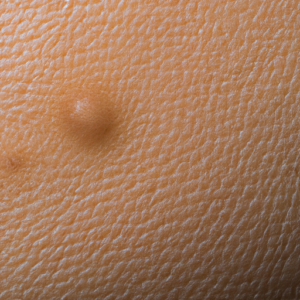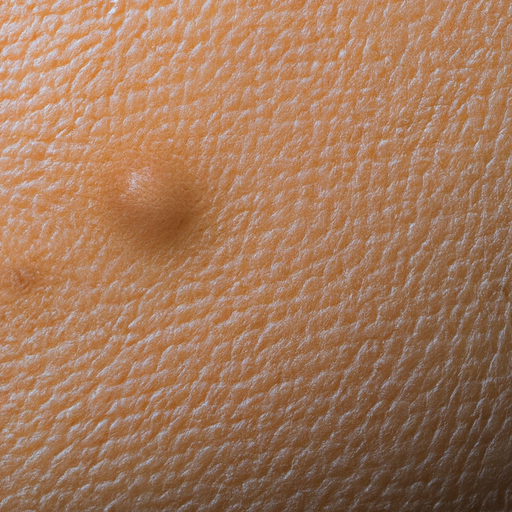Get to know Lentigo: A Spot on Your Skin
Hey there! Have you ever noticed a small dark spot on your skin that wasn’t there before? Chances are, it could be a lentigo. Lentigos are common skin findings that often appear on areas of the body that gets a lot of sun exposure such as the face, arms, neck, and hands.
So what exactly is a lentigo? A lentigo is a type of skin lesion that appears as a flat, light to dark brown and black pigmented macule type of lesion. They can range in size from a few to several millimeters and could be solitary or in groups.
Now that we have an idea of what a lentigo is, let’s dive deeper into the different types of this skin lesion in the next section.
The Many Different Types of Lentigos: What You Need to Know
As someone who suffers from Lentigos, it’s important to be familiar with the various types of the condition. Lentigos are typically identified as black or brown spots on the skin caused by the accumulation of cells that produce pigment. Some types of Lentigos are:
1. Solar Lentigos: These types of Lentigos are caused by sun exposure. They tend to appear on the face, arms, and chest, and can vary in shape and size.

2. Progressing Pigmented Lentigos: This type of Lentigo starts as a small lesion and slowly progresses with time. They are typically benign, but they can develop into melanoma in some cases.
3. Simple Lentigos: These Lentigos are most often found in children and can fade away over time.
4. Becker’s Nevus: This is a large lentigo that can be present at birth or appear in puberty. It is more commonly found in men and can occur on the upper torso or back.
5. Dysplastic Lentigos: These are abnormal Lentigos that require close observation because they can sometimes develop into malignant melanoma.
By being familiar with the different types of Lentigos, you can take better care of your skin and keep a closer watch on any changes or developments. Consult with a dermatologist if you have concerns or questions about your Lentigos.
Symptoms of Lentigo
Alright y’all, let’s talk about the symptoms of lentigo. If you’re dealing with this skin condition, you might notice that you’ve got some brown spots on your skin – they can be anywhere on your body but are most commonly found on your face, hands, and arms. I’m talking about flat, oval-shaped areas that are darker than your surrounding skin.
Another symptom might be that these spots are multiplying – you might start with one or two, but over time you’ll notice more popping up. This can be frustrating and difficult to keep up with. You might also notice that these spots aren’t painful or itchy – they’re just there.
If you’ve been spending a lot of time in the sun, you might also notice that these spots darken or get larger after exposure to UV rays. This is a common symptom and can be a sign that you need to be more diligent about sunscreen and protecting your skin.
Some people might notice that these spots are changing in shape, color, or size – this could be a sign of something more serious, so it’s important to keep an eye on them and talk to your doctor if you notice any changes.
Finally, y’all should know that lentigo can be more common in certain populations – people with fair skin, people over the age of 50, and those who have spent a lot of time in the sun are all at higher risk. So, if any of these symptoms sound familiar, it’s worth talking to your doctor about your risk and how to prevent further spots. Don’t ignore your skin – it’s the only one you’ve got!
What’s Causing My Lentigo?
Let me tell you something – despite its harmless appearance, lentigo can be caused by a variety of things, some of which may be more serious than others. The most common cause of lentigos is exposure to the sun, particularly in people with fair skin. Other triggers can include aging, hormonal changes like pregnancy or menopause, genetics, and, in rare cases, certain medical conditions.
Some drugs and medications can cause lentigo too, including hormone therapy drugs, some antibiotics, and chemotherapy drugs, so it’s important to note any medications you’re taking when discussing your condition with a dermatologist. Certain lifestyle factors can also contribute to the development of lentigo, such as smoking, diet, and excessive alcohol consumption.
One of the more concerning causes of lentigo is the development of skin cancer. In some cases, atypical or dysplastic lentigo can progress to melanoma, an aggressive form of skin cancer that requires immediate medical attention. That’s why it’s important to get a professional diagnosis if you have any concerns about the appearance of your lentigo or skin spots.
Ultimately, the cause of your lentigo will depend on a variety of factors, and it’s essential to get a proper diagnosis and treatment plan that takes your unique situation and medical history into account. So don’t hesitate to reach out to a dermatologist if you’re worried about any spots or skin changes you’ve noticed – it could be the key to catching something serious in its early stages.
Diagnosing Lentigo
So you’ve noticed an odd spot on your skin. It could be lentigo, or it could be something else entirely. The only way to know for sure is to consult a dermatologist. They’ll examine the spot and ask you about your medical history, as lentigo is sometimes associated with certain medical conditions.
If the dermatologist suspects lentigo, they may do a skin biopsy where a small sample of the skin is removed and examined under a microscope to confirm the diagnosis. Additionally, they may use a special light called a Wood’s lamp to examine the spot, as lentigo may appear darker under this type of light.
It is important to remember that not all spots on the skin are lentigo, and not all lentigos are cancerous. However, it’s always better to err on the side of caution and get suspicious spots checked out by a professional. Early detection of skin cancer can make a huge difference in treatment outcomes.
If you have a history of skin cancer or have many lentigos, the dermatologist may advise more frequent skin checks or other preventive measures. Take care of your skin and always listen to expert medical advice.
Treatment for Lentigo
So, you’ve been diagnosed with a lentigo? No worries! Treatment options are available that can help you get rid of those pesky pigmentation spots. Here are some treatment options you can consider:
Cryotherapy
During this treatment, the lentigo is destroyed using extreme cold. Cryotherapy involves using a device that produces liquid nitrogen, which is then applied to the lesion for a few seconds. After this, the treated area might blister and scab over, but this will eventually fall off, leaving healthy skin behind.
Laser therapy
In this treatment, the lentigo is destroyed using laser energy. The laser is passed over the lesion, and the energy is absorbed by the pigmented cells, causing them to break down. This type of therapy is less painful than other methods and is also less invasive.
Chemical peels
In this procedure, a solution of chemicals like trichloroacetic acid or glycolic acid is applied to the skin. It causes the top layer of skin cells to peel away, revealing healthier, lighter skin underneath. This is a great option for those with a large number of lentigos or for people who wish to improve the overall texture and appearance of their skin.
While these treatments are effective for treating lentigo, it’s important to note that prevention is always better than cure. If you want to avoid developing lentigos in the future, remember to regularly apply sunscreen and wear protective clothing when out in the sun. And if you already have lentigos, don’t be afraid to consult a dermatologist and explore these treatment options.
For more information on lentigos and treatment options, read this article from Brightside Beauty.
Prevent lentigo from happening to you!
If you want to avoid developing lentigo, you need to protect your skin from the most harmful UVA/UVB rays of the sun by wearing a sun hat, long sleeve cover-ups, and using good quality broad-spectrum sunscreens with SPF 30+ daily. Also, it is crucial to avoid tanning beds, as they emit a form of UV radiation that is particularly damaging to the skin.
Another valuable recommendation is to avoid exposing your skin to direct sunlight during the peak hours from 10 am to 4 pm, where the sun’s rays are most damaging. And it is essential to follow the instructions of any topical medication your doctor may have prescribed to reduce the risk of developing lentigo or preventing its recurrence.
You should also consider maintaining a healthy diet that contains plenty of antioxidant-rich foods, such as fruits, vegetables, nuts, seeds, and whole grains that protect the skin from free radicals, which cause premature aging of the skin and increases in lentigo.
One further recommendation is to quit smoking, as tobacco contains chemicals that damage the DNA in your skin’s cells and leads to the production of free radicals. Finally, ensure you have regular skin cancer screenings with a dermatologist to identify the presence of any skin abnormalities early, including lentigo, so you can act quickly.
My Final Thoughts: Overcoming Lentigo
Well folks, that’s a wrap on Lentigo. As someone who’s had their fair share of skin woes, I know firsthand how frustrating it can be to deal with skin conditions. But don’t let Lentigo get you down! There are plenty of treatment options available, and if all else fails, there are always ways to prevent it from happening in the first place.
Remember, Lentigo doesn’t discriminate – it can affect anyone of any race or age. That being said, certain groups may be more prone to developing Lentigo, such as those with fair skin or a history of sun exposure. Educate yourself on the causes and symptoms of Lentigo, and pay attention to any new or changing spots on your skin.
If you think you might have Lentigo, don’t wait to seek medical advice. Your doctor or dermatologist can diagnose the condition and recommend the best course of treatment for you. From topical creams to laser therapy, there are numerous ways to address Lentigo. And, as always, it’s important to practice good sun protection habits to prevent further damage to your skin.
In conclusion, don’t let Lentigo steal your skin’s natural beauty! With the right care and treatment, you can keep your skin healthy and radiant. Stay vigilant and don’t hesitate to reach out to a medical professional if you have any concerns. Take care of yourself, and happy healing!
